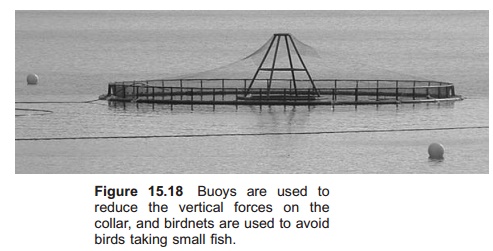Chapter: Aquaculture Engineering : Sea Cages
Buoys - Mooring systems
Buoys
Buoys are used to hold the mooring lines up so that vertical forces on the collar are avoided (Fig. 15.18).
They will also take up the weight of the mooring system so this is not transferred to the cage if placed some distance (normally 15–20 m) away from the collar. By limiting this distance, spreading of the mooring system will also be avoided. Furthermore, to ensure horizontal transference of forces, the buoys have a major roll in pre-stressing the farm by pre-stretching the mooring lines. Buoys will also function like extension springs and damp wave movements, for instance. When a load is added to the cage the buoy will be dragged down and not so much will be seen on the surface; if the load is removed it will float up again.

Typical buoy sizes are from 200 to 700 l. The buoys can be filled with air or foam. To avoid puncturing reducing the buoyancy, the use of foam filled buoys is highly recommended, and in some places is mandatory. Expanded PS or polyurethane (PU) is commonly used. If an air-filled buoy is dragged below the water surface the buoyancy will decrease rapidly because the buoy is compressed; reduced volume results in reduced buoyancy. Foam-filled buoys will also be compressed when beneath the water surface. PVC foam filling will tolerate more pressure, but is more expensive than PU. The buoyancy of the buoys is recommended to be somewhat higher than the calculated requirement, twice what is necessary, for instance. Round, cylindrical and polygonal buoys are used in mooring systems. Experiments in which single buoys were replaced with multiple floats covering a distance of the rope showed that these gave a much smoother dynamic response on the anchor lines.
A lump weight can be added to the mooring line between the cage collar and the buoys. This makes it possible to go over the lines by boat, and will also function as an additional pre-stressor of the farm and reduce jerks in the lines. However, the wear

From the buoys the mooring lines go to the mooring points. Depth–length ratios are commonly set to 2.5–4. Long anchor lines reduce the vertical forces and reduce the required buoyancy in the buoys, but have the disadvantages that a greater area is needed and the cost of the mooring lines is increased.
The magnitude of the pre-stress in the mooring lines for a cage farm depends on the site and other factors. One method is to pre-stress at high tide so that 75% of the volume of the buoy is below the surface and 25% is above to take additional loads. Inspection of the buoys could then constitute a simple control of the mooring system. Since all mooring lines are equal and equally pre-stressed, all buoys will have the same volume above the surface. It can be an advantage to have distinct marks on the buoys to control more easily how much of the buoy volume is below the surface. This check must, however, be done when no environmental forces affect the cage. If, for instance, a current is coming in from one side, the buoys on this side will be dragged down and those on the opposite side will float higher in the water as a result of the unequal loads on the mooring lines.
Related Topics